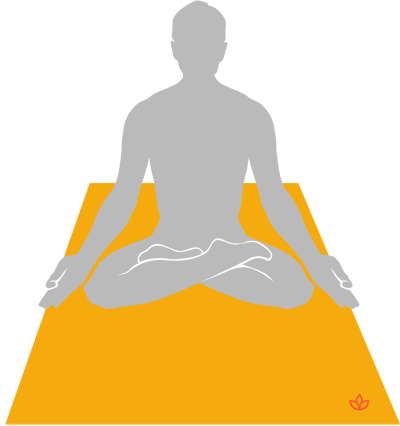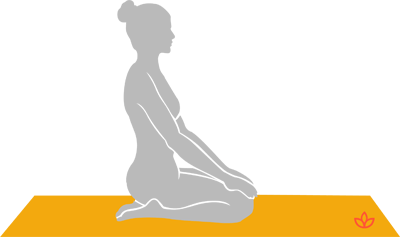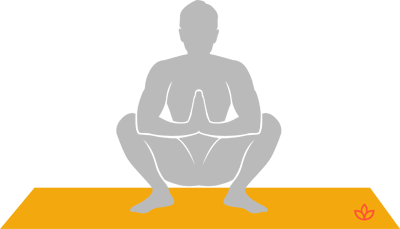When I was new to the meditation cushion, I found it very difficult to sit straight in various seated poses and while meditating. Thanks to modern lifestyle, the tendency to slouch is prevalent and seems comfortable. However, the effects of slouching do not offer as much comfort as a correctly seated posture, which goes a long way in maintaining health and helping to enjoy the optimal benefits of meditation. Here I'll explain to the benefits of sitting properly as well as how to perfectly perform three popular poses for a meditation practice.
Benefits of Perfect Posture
Taking a seated posture properly offers a wide range of health benefits, including:
- Improves lung capacity and lung health
- Supports proper flow of energy
- Supports spinal health
- Relieves back pain (Concerned about maintaining back and spinal health? Try these 4 Yoga Poses for a Strong Back.)
- Boosts confidence
- Alleviates stress and improves mood
Assuming a properly seated posture is essential while meditating. Sitting with the spine straight promotes energy flow. Sitting properly helps one to meditate for a longer duration without feeling pain in the back and also prevents the legs from falling asleep. Correctly seated postures keep you relaxed yet aware.
How to Properly Take a Seated Posture
While taking a seated posture for meditating, you may wonder which would be the right place to sit – the floor or the chair. While opting for the floor is highly recommended, sitting on a chair is suggested for those with health conditions or who find sitting on the floor too uncomfortable. (Read more about how to get started meditating in Meditation: How to Find the Starting Point.)
Here are the important factors you need to follow while taking a seated posture:
- Sit straight with your spine erect yet relaxed
- Shoulders are rounded, down and relaxed
- Tuck in your chin and keep your head balanced without tilting on either side
- Place your palms on your thighs with your elbows at your sides
- Observe if all of your muscles and joints are relaxed (Discovering Yourself Through a Body Scan Meditation can help with this.)
- Close your eyes, relax the facial muscles, relax your tongue
- If you would like to meditate in lotus pose, you may assume the chinmudra
3 Seated Poses for Meditation
Lotus Pose
While assuming the lotus pose, the spine should be straight. Keep your chin slightly tucked and your eyes closed. Let your hands be relaxed in chin mudra. (Learn how to perform this and nine more mudras in The Best of the Mudras.) You may also keep your hands on your lap with your palms facing up.
Directions:
- Sit straight on the meditation cushion or yoga mat with the legs stretched forward.
- Bend your right leg at the knee and place your right foot on the left thigh. The right heel should be by the crease of your left hip.
- Now bend your left leg and place the left foot on the right thigh. The left heel should be placed by the crease of your right hip. Do not lift your knees off the floor.
- Assume chin mudra with your hands and place them on the knees.
- Keep your eyes closed and maintain normal breathing.

Thunderbolt Pose
A beginner may find it difficult to remain in lotus pose throughout the duration of meditation. To avoid the focus shifting from meditation to the feeling of uneasiness, it is suggested to meditate in an easier pose, such as thunderbolt pose. While in this pose, keep your palms on your knees. If your ankles hurt, you may use blankets underneath them for support.
Directions:
- Kneel down on the mat with or without a meditation cushion with your spine straight.
- Place the thighs together.
- Space out the heels. The big toes should maintain contact so that you form a "V" shape with your feet.
- Place your buttocks on the gap between the heels.
- Let the palms rest on the knees.
- Close your eyes and maintain normal breathing. (This is because Conscious Breathing Will Boost Your Yoga Practice.)

Garland Pose
Meditating in garland pose, or malasana, requires more endurance and, as such, can really give you a thoroughly satisfying experience. Termed the "yogi's squat," squat meditation has a long list of health benefits to offer. Squatting tones the lower body and promotes a healthy digestive system. It also elongates the spine, supports abdominal breathing, improves balance and focus, and promotes self-awareness.
Directions:
- Stand straight with your legs apart, maintaining hip-width distance.
- Squat with the feet firmly on the floor. Your knees should be pointed upward.
- Bring your torso forward between the legs. The hands should also be between the legs.
- Place your palms together assuming prayer pose.
- Keep your head facing forward.
- Close your eyes and maintain normal breathing.

Are You Sitting Down for This?
Taking the right seated posture while meditating maximizes all related health benefits. It improves your focus, optimizes your breathing capacity, energizes the whole body and helps you to feel fantastic when you come out of your meditation session. Slouching may initially seem more comfortable, but remember its ill effects and what you gain by assuming the right seated posture. You are sure to enjoy every second of your sitting session in the right way, on and off the mat. (Read on about another yogi's tips for sitting properly during meditation in Effective Seated Postures for Meditation.)
During These Times of Stress and Uncertainty Your Doshas May Be Unbalanced.
To help you bring attention to your doshas and to identify what your predominant dosha is, we created the following quiz.
Try not to stress over every question, but simply answer based off your intuition. After all, you know yourself better than anyone else.